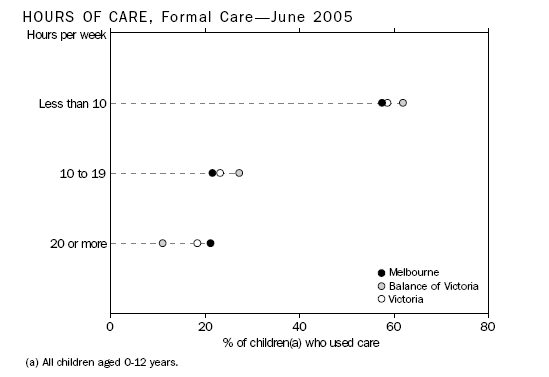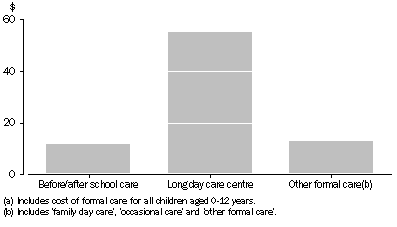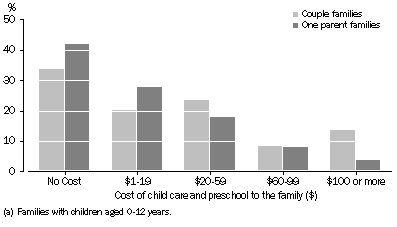Feature Article - Child Care Usage in Victoria
Introduction
This article presents information about the use of child care in Victoria. Data in this article was obtained from the 2005 Child Care Survey for children aged 0-12 years.
The Child Care Survey was conducted throughout Australia in June 2005 as a supplement to the Australian Bureau of Statistics (ABS) monthly Labour Force Survey. The 2005 Child Care Survey is a continuation of a series of surveys on the topic of child care conducted since 1969. The previous survey was in June 2002.
Child care refers to arrangements (other than care by resident parents) made for the care of children aged 0-12 years. The Child Care Survey collected information about formal and informal child care. Formal child care refers to regulated care that takes place away from the child's home, for example long day care, before and/or after school care and family day care. Informal care refers to non-regulated care that takes place in the child's home or elsewhere. It includes care by family members, friends, neighbours, baby sitters and nannies. Parents often use a combination of formal and informal child care for their children.
In 2005, preschool was excluded from the definition of formal care due to the widely-accepted view that the main focus of preschool is education and preparing children for school, rather than child care.
Use of child care
Cost of care
Work and child care
Preschool attendance
USE OF CHILD CARE
Formal care and informal care
In June 2005, 374,500 children aged 0-12 years received some type of child care in Victoria during the reference week. This represented 46% of children in this age group. Formal care, either alone or in combination with informal care, was used by 20% (165,000) of children in the reference week. Informal care, either alone or in combination with formal care, was used by 33% (268,800) of children aged 0-12 years.
The most commonly used types of formal care were long day care and before and/or after school care, attended by 8% and 7% of all children aged 0-12 years respectively. These were followed by family day care (3%) and occasional care (2%) while other forms of formal child care were used by less than 1% of children.
In terms of informal care, grandparents were the main informal carers, providing care for 20% of all children.
Use of care by children of different ages
Child care usage varied with age for both formal care and informal care. In Victoria, the use of formal care for young children (0 to 2 years) was 23%. This increased to 43% for children aged 3 to 4 years, before dropping to 14% for children aged 5 to 12 years. In comparison, the use of informal care was 37% for young children (0 to 2 years) and rose to a peak of 43% for children aged 3 to 4 years, before falling to a low of 29% for children aged 5 to 12 years.
Hours of Care
In terms of formal care, most children used relatively few hours of child care. This was evident in both Melbourne and the Balance of Victoria. Of those children attending formal care in Melbourne, 57% spent less than 10 hours per week in formal care. In the Balance of Victoria, the proportion was slightly higher, with 62% using formal care for less than 10 hours per week during the reference period. There was a higher proportion of children spending between 10 and 19 hours per week in formal care in the Balance of Victoria (27%) compared to Melbourne (22%). However, the proportion of children who attended formal care for 20 hours or more per week was much lower in the Balance of Victoria (11%) than in Melbourne (21%). The median number of hours for all children aged 0-12 years who used child care in Victoria was 9 hours in the reference week.

Similarly, with informal care most children used relatively few hours of child care. In Melbourne, 59% of children who used informal care accessed less than 10 hours per week, while in the Balance of Victoria the figure was 53%. By contrast, for those children who attended informal child care for 20 hours or more per week in the reference period, the Balance of Victoria had a higher proportion of children using informal care (27%) than Melbourne (21%).
Couple and one parent families
A higher proportion of children in one parent families (53%) used child care than children in couple families (44%). Both family types were more likely to use informal care than formal care. Among children from one parent families, 39% used informal care and 24% used formal care. Of children from couple families the proportions were 31% (informal) and 19% (formal).
Care provided by grandparents was important for children in both couple and one parent families (21% and 15% of children respectively). However, care provided by other relatives including the child's other parent living elsewhere, siblings and other more distant relatives played a greater role for children in one parent families (26%) than for those in couple families (11%).
Whether required additional formal care
The survey sought information from parents about whether their formal child care requirements were met. Those families not using formal care were asked whether there was any time in the last four weeks when they wanted to use any formal care services but didn't. Those families already using formal child care were asked whether there was any time in the previous four weeks when they wanted to use any more formal care services but didn't.
According to parents' responses, of the total 821,600 children aged between 0 to 12 years in Victoria, there was a requirement for additional formal care for approximately 43,400 children (5%). This was similar to the national proportion (6%). The vast majority of children in Victoria (778,100 children or 95%) required no additional formal care.
In Victoria, of the 95% of children that did not require additional formal care, the main reason provided by parents for not requiring any additional care was that a parent was not working, or they preferred/were available to look after the child. This applied for 57% of all children that did not require additional formal care. This proportion was higher in the Balance of Victoria (62%) compared to Melbourne (55%).
COST OF CARE
Cost of care information measured by the 2005 Child Care Survey is the cost of care to the parents after the Child Care Benefit has been taken into account. This cost does not take into account the new Child Care Tax Rebate introduced in December 2005. (For more detailed information about the Child Care Tax Rebate and the Child Care Benefit, refer to the Explanatory Notes in the ABS publication
Child Care Australia, June 2005 (cat. no. 4402.0). As well as any Child Care Benefit entitlements, the cost of care is influenced by factors such as the hours spent in care and the different fees for different types of care.
For 69% (259,600) of children who used child care during the reference period, the cost of that week's care was less than $20 (this includes a large proportion of children for whom there was no cost), while for 7% of children it was $100 or more. There was a cost involved for almost all children who used formal care (96%). In contrast, the majority of informal care was provided free of charge, with a payment being made for just 10% of children using informal care.
The median weekly cost per child of all formal care was $25. The cost of care was highest for long day care, indicated by a median weekly cost of $55.
Median weekly cost of formal care for child(a), Victoria
- June 2005

Estimates of child care costs per family were also available, but only for informal care and an aggregate of formal care and preschool. The total median weekly cost for couple families was $15 in the reference week, compared to $4 for one parent families. These low median values are largely influenced by the fact that many families did not have to make any payments for their use of informal care.
Cost of Care To The Family(a) Including Preschool Costs, Victoria
- June 2005

WORK AND CHILD CARE
Use of work arrangements to help care for children
People used a range of work arrangements to help them care for their children. These included flexible working hours, permanent part-time work, shift work, work from home and job sharing arrangements.
Of all families in Victoria with at least one parent employed, 59% indicated that at least one parent normally used one of these work arrangements to help them care for their children. This compares to 61% nationally.
The most frequently used arrangements were flexible working hours (38%), permanent part-time work (27%) and working at home (14%). Overall, employed mothers in both couple and one parent families were considerably more likely to make use of these types of work arrangements (73%) than employed fathers (31%). In couple families, 31% of employed fathers used these work arrangements compared to 58% of employed fathers in one parent families.
Preschool Attendance
Of the 74,800 children who attended preschool in the reference week in 2005, 45% attended for fewer than three days and 55% attended for three days or more. Of these children, the main reasons for choosing a particular preschool were convenience (39%) and quality/reputation of that preschool (32%).
For further detailed information, please refer to Child Care Australia, June 2005, (cat. no. 4402.0).
 Print Page
Print Page
 Print All
Print All